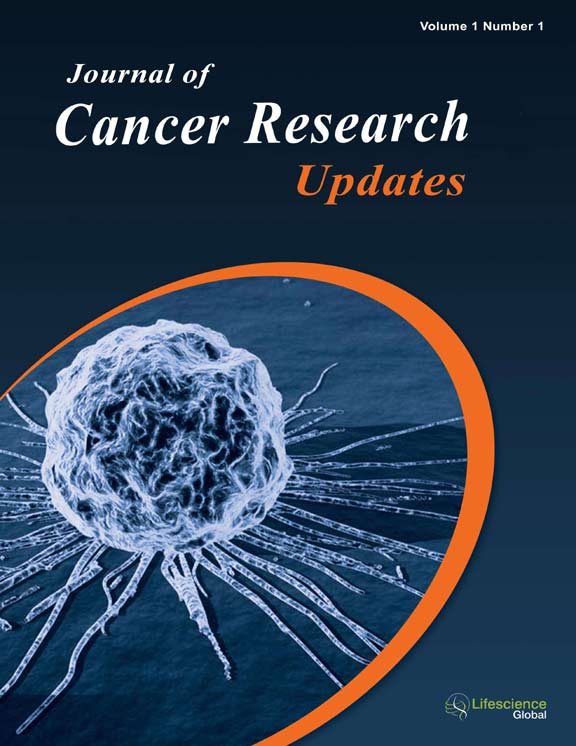jcru
Editor’s Choice : Molecular Genetic Study of the Allelic State of the Cell Cycle Genes (TP53, BRCA1) and Features of the Regulation of the Cytokine Cascade in Breast Cancer
|
|
Abstract: This article contains the analysis of mutations in genes that regulate the cell cycle (TP53 and BRCA1) and classification relating to tumor suppressor. Shown that the "risk" alleles of these genes may contribute to tumor development, but the activation of the immune system cytokine spectrum of patients can prevent their destructive degeneration. The authors proposed a personalized approach to the study for the prevention of possible proliferative processes. This is confirmed by reversal of "risk" alleles studied genes in tumors in operated patients with cytokine physiologically normal status. Keywords: Breast cancer, tumor suppressor, cytokines, nucleotide substitutions, predisposition.Download Full Article |
Editor’s Choice : Disease–Free Remission Exceeding 37 Years in Patients Treated as Children for Acute Leukemia (AL) with Immunotherapy Using Viable (Cryopreserved) Allogeneic Leukemic Cells
|
|
Abstract: At present time in spite of great achievements in modern chemotherapy of acute leukemia (AL) the issue of eradication of residual leukemic cells (MRD) is still relevant. Since 1971 we included specific immunotherapy in the treatment of children with acute lymphoblastic leukemia in remission using viable cryopreserved allogeneic leukemic cells. 67 children in remission were divided into 2 groups: 27 constituted the control group (only continued standard-for-that-time chemotherapy) and 40 children – the treatment which received immunotherapy in addition to standard chemotherapy. In 3 years all children in the control group relapsed. The median length of remission was 15 months. In the treatment group we observed stabilization of remission only in children over 7 years of age when immunization was initiated after 6 or more months of remission and in children younger than 7 if it was initiated after 1-1,5 years of remission. The median length of remission was 60 months which significantly exceeded (4 times) that parameter in the control group of children. Cytotoxic antibodies against leukemic cells appeared in the serum of effectively immunized children at a higher titer than against donor lymphocytes. Intrathecal administration of this hyperimmune serum to patients with neuroleukemia resistant to chemotherapy led to a sharp decrease in the amount of leukemic cells in the spinal fluid. After 5 years of remission (and 3-5 years of immunotherapy) all treatment in these patients was stopped. Out of 19 patients who received immunotherapy on time, 8 patients (42%) have been in event-free remission for 37 to 41 years (median – 38 years) through the present time and enjoy high quality of life. Our results indicate that immunotherapy initiated during remission period of AL can lead to creation of anti-leukemic immunity with subsequent eradication of MRD and complete recovery. Keywords: Acute leukemia, Immunotherapy, Cryopreserved leukemic cells, Prolongation of remission, Immunological indices.Download Full Article |
Editor’s Choice : Vemurafenib (PLX4032, Zelboraf®), a BRAF Inhibitor, Modulates ABCB1-, ABCG2-, and ABCC10-Mediated Multidrug Resistance
|
|
Abstract: In this study, we examined the in vitro effects of vemurafenib, a specific inhibitor of V600E mutated BRAF enzyme, on the response of cells overexpressing the ATP binding cassette (ABC) efflux transporters ABCG2, ABCB1, ABCC1 and ABCC10. Vemurafenib, at 5 µM and 20 µM, produced a significant concentration-dependent increase in the cytotoxicity of paclitaxel in cells overexpressing ABCB1 and ABCC10 and mitoxantrone in cells overexpressing ABCG2. Vemurafenib also significantly enhanced the accumulation of paclitaxel in cell lines overexpressing ABCB1 and ABCC10. Vemurafenib significantly increased the intracellular accumulation of mitoxantrone in cells overexpressing ABCG2. In contrast, vemurafenib did not significantly alter the sensitivity of ABCC1 overexpressing HEK/ABCC1 cells to vincristine. Finally, as determined by Western blotting, vemurafenib (20 µM) did not significantly alter the expression of the proteins for ABCG2, ABCC10 or ABCB1. Thus, vemurafenib most likely reverses multidrug resistance by altering the transport function of these aforementioned ABC transporters, as opposed to affecting the expression of ABC proteins. The docking analysis of vemurafenib with the ABCB1 homology model also suggested that vemurafenib binds to the ABCB1 and ABCG2 drug binding site. These findings suggest that combination of specific inhibitors like vemurafenib with chemotherapeutic drugs may be used to overcome multidrug resistance in cells that overexpress ABCB1, ABCC10 and/or ABCG2 transporters. Keywords: Vemurafenib, ABCC10, ABCG2, MDR.Download Full Article |
Editor’s Choice : Is the Neoadjuvant Docetaxel, Cisplatin and 5-Fluorouracil Regimen Superior to Classic Cisplatin and 5-Fluorouracil for Locoregionally Advanced Nasopharyngeal Carcinoma?
|
|
Abstract: Objectives: We retrospectively compared the toxicity and efficacy of two neoadjuvant chemotherapy regimens (docetaxel+cisplatin+5-fluorouracil vs. cisplatin+5-fluorouracil) followed by chemoradiotherapy for locoregionally advanced nasopharyngeal carcinoma. Patients and Materials: We analysed 135 patients with stage III and IVA-B nasopharyngeal carcinoma. Forty-four patients were treated with docetaxel+cisplatin+5-fluorouracil and chemoradiotherapy (TPF group), and 91 were treated with cisplatin+5-fluorouracil and chemoradiotherapy (PF group). Chemoradiotherapy was administered with weekly cisplatin. Radical radiotherapy with total doses of 70–74Gy was administered using a conventional technique, over 7 weeks in 2.0Gy/fraction; boost doses of 6–10Gy were administered in 55.6% patients (n=75) with locally advanced cancer. Results: The median follow-up was 46.5 months (range, 9.8–62.8 months), and the follow-up rate was 95%. The TPF group had better 5-year estimated progression-free survival (77.0% vs. 73.5%; P = 0.510) and overall survival than the PF group (80.7% vs. 77.9%, P = 0.446); however, there was no statistically significant difference between the groups. Toxicities in the two groups were similar; grade 3/4 oral mucositis was more common in the TPF group (27.3%) than in the PF group (15.3%) during chemoradiotherapy. Conclusions: The neoadjuvant docetaxel+cisplatin+5-fluorouracil chemotherapy led to satisfactory long-term survival and slight improvement in progression-free survival and overall survival as compared with the classic cisplatin+5-fluorouracil regimen; toxicity was tolerable. However, prospective trials are needed to prove whether docetaxel+cisplatin+5-fluorouracil is a substitute for cisplatin+5-fluorouracil. Keywords: Nasopharyngeal carcinoma, induction-concurrent chemotherapy, docetaxel, cisplatin, 5-fluorouracil.Download Full Article |



